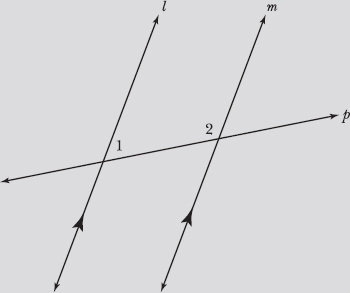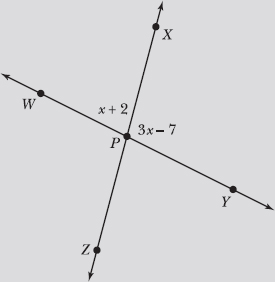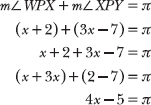Complementary and Supplementary Angles
Sums of 90° and 180°
Note: Problems 1.31–1.33 refer to the diagram below, in which ![]() and
and ![]() are complementary.
are complementary.

1.31 Create an equation that describes the relationship between the numbered angles in the diagram.
If two angles are complementary, then the sum of their measures is 90°. In the given diagram, angles CBD ![]() and ABD
and ABD ![]() together form right angle ABC. Recall from geometry that perpendicular lines (like the x- and y-axes) form right angles, which measure 90°. Therefore, the sum of the measures of the angles is 90°:
together form right angle ABC. Recall from geometry that perpendicular lines (like the x- and y-axes) form right angles, which measure 90°. Therefore, the sum of the measures of the angles is 90°:
![]()
In the equation above,![]() and
and ![]() represent the measures of
represent the measures of ![]() and
and ![]() , respectively.
, respectively.
Note: Problems 1.31–1.33 refer to the diagram in Problem 1.31, in which ![]() and
and ![]() are complementary.
are complementary.
1.32 Given m![]() =31°, calculate m
=31°, calculate m![]() .
.
The problem states that ![]() and
and ![]() are complementary, so the sum of their measures is 90°.
are complementary, so the sum of their measures is 90°.
![]() +
+![]() =90°
=90°
Substitute ![]() =31° into the equation and solve for
=31° into the equation and solve for ![]() .
.

Note: Problems 1.31–1.33 refer to the diagram in Problem 1.31, in which ![]() and
and ![]() are complementary.
are complementary.
1.33 Given ![]() , calculate m
, calculate m![]() .
.
This is just like Problem 1.32, but this time you’re working in radians instead of degrees.
Complementary angles have measures that sum to 90°. This problem expresses the degree measure in radians, so you should begin by converting 90° to radians as well.

Problem 1.24 explains this step—how to convert from degrees to radians.
Therefore, complementary angles measured in radians have a sum of π/2.
![]()
Substitute ![]() = π/11 into the equation
= π/11 into the equation
![]()
Multiply both sides of the equation by 22, the least common multiple of 2 and 11, to eliminate the fractions.

Reduce the fractions to lowest terms and solve for m∠1.

The complement of π/11 is 9π/22.
1.34 In the diagram below, right triangle XYZ has acute angle Z that measures ![]() . Calculate the measure of the remaining acute angle.
. Calculate the measure of the remaining acute angle.

The small square located at Y indicates that ![]() , so
, so ![]() is a right angle. According to a geometric theorem, the acute angles of a right triangle are complementary. Recall that acute angles measure less than 90° (or π/2 radians), so in this triangle,
is a right angle. According to a geometric theorem, the acute angles of a right triangle are complementary. Recall that acute angles measure less than 90° (or π/2 radians), so in this triangle, ![]() and
and ![]() are acute.
are acute.
The measures of the angles in a triangle add up to 180°. If you subtract the 90° right angle from this total, the two remaining acute angles have to add up to the remaining 90°, so they are complementary. For more details, see Problem 7.28 in The Humongous Book of Geometry Problems.
![]()
According to the diagram, ![]() = π/6. Substitute this value into the equation above and solve for
= π/6. Substitute this value into the equation above and solve for ![]() .
.

Express the fractions in terms of the least common denominator, 6.

Reduce the fraction to lowest terms.

You conclude that ![]() = π/3.
= π/3.
Note: Problems 1.35–1.37 refer to the diagram below, in which ![]() are supplementary.
are supplementary.

1.35 Create an equation that describes the relationship between the numbered angles in the diagram.
A pair of angles is supplementary if their measures have a sum of 180°. In the given diagram, angles 3 and 4 combine to create a straight angle—the line ![]() . Lines are also described as “straight angles” and have a measure of 180°. Therefore, angles 3 and 4 are supplementary, and their measures have a sum of 180°.
. Lines are also described as “straight angles” and have a measure of 180°. Therefore, angles 3 and 4 are supplementary, and their measures have a sum of 180°.
![]()
Note: Problems 1.35–1.37 refer to the diagram in Problem 1.35, in which ![]() are supplementary.
are supplementary.
1.36 Given ![]() = 75°, calculate
= 75°, calculate ![]() .
.
According to Problem 1.35, angles 3 and 4 are supplementary. Therefore, their measures have a sum of 180°.
![]()
Substitute ![]() = 75° into the equation and solve for
= 75° into the equation and solve for ![]() .
.

Note: Problems 1.35–1.37 refer to the diagram in Problem 1.35, in which ![]() are supplementary.
are supplementary.
1.37 Given ![]() , calculate
, calculate ![]() .
.
The measures of supplementary angles have a sum of π.
![]() x
x
180° = πradians
Substitute ![]() = 5π/7 into the equation and solve for
= 5π/7 into the equation and solve for ![]() .
.

1.38 In the diagram below, parallel lines l and m are intersected by line p, which produces same-side interior angles 1 and 2. Given ![]() , calculate
, calculate ![]() .
.

Arrowheads in the middle of lines indicate that the lines are parallel to each other.
According to a geometric theorem, when two parallel lines are intersected by a third, non-parallel line (called the transversal), same-side interior angles are supplementary. Same-side interior angles are defined as two angles on the same side of the transversal located between the parallel lines.
In other words, angles 1 and 2 are same-side interior angles because they are both on the same side of p (both are above the line) and both are located between parallel lines l and m. Therefore, the angles are supplementary. Note that the problem presents an angle measured in radians, so rather than set the sum of the supplementary angles equal to 180°, you should set it equal to π.
![]()
Substitute ![]() = π/5 into the equation and solve for
= π/5 into the equation and solve for ![]() . Note that you will need to use common denominators to simplify the result.
. Note that you will need to use common denominators to simplify the result.

1.39 Calculate x in the diagram below. Express the answer in terms of radians.

Because ![]() and
and ![]() combine to form a straight line—which measures π radians—you can conclude that the angles are supplementary. Thus, the sum of their measures is equal to π.
combine to form a straight line—which measures π radians—you can conclude that the angles are supplementary. Thus, the sum of their measures is equal to π.


The answer ![]() is also correct.
is also correct.
